You already know The Brooklyn Bridge is the most iconic structure in NYC.
Known as the 8th wonder of the world, it was originally built to connect the two city halls of Brooklyn and Manhattan together when they were separate cities in 1883. Originally, the only way across the East River was by ferry, but the river kept freezing up solid in the late 1800’s, so the two Mayor’s demanded a bridge be built. The Brooklyn Bridge essentially connected two separate cities with two separate Mayors.
- Now, if you want boring information, the towers stand 276 feet above water.
- If you want useful information, then you should know that walking across that Bridge is one of the quintessential, and one of the few FREE New York City experiences, so please try it!
- If you want odd information…Keep reading!
1. Construction of the Brooklyn Bridge was cursed.
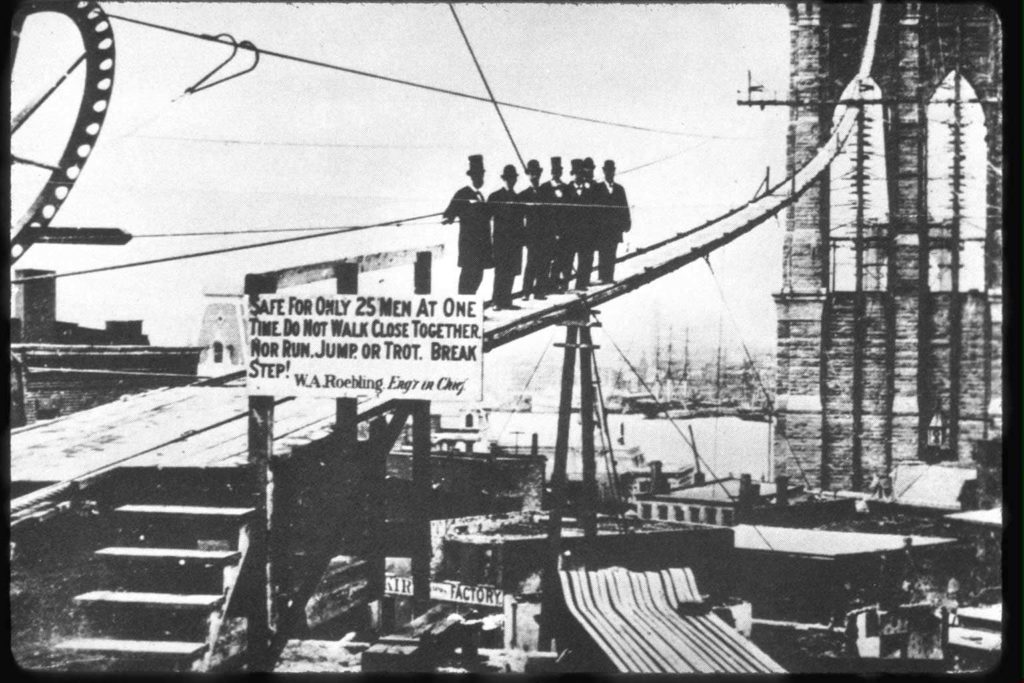
At least 20-30 people died during construction of the bridge including its designer John Roebling. Some workers met their fate by falling off the 276-foot-high towers, while others were hit by falling debris.
Then there was the illness. Many of the men who worked on the first tower in Brooklyn started getting sick. They called is Caisson’s Disease named after the large, watertight pillars they worked in. We now know they got sick because they didn’t decompress after working deep underwater. Over 110 people got compression sickness. Yikes!
2. Corrupt politician, Boss Tweed, played a major role in getting the Brooklyn Bridge built.
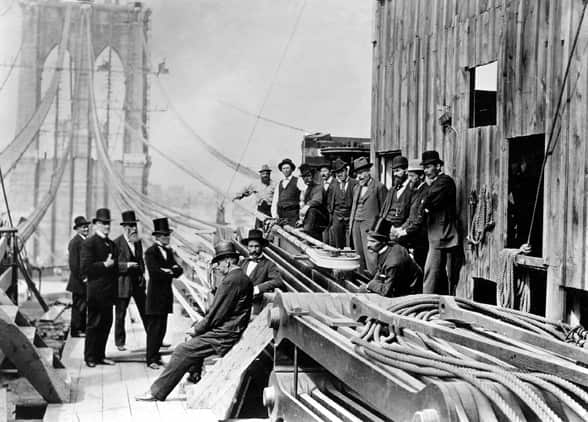
You’ve probably heard of one of the most notorious politicians in US history William M. “Boss” Tweed. Tweed was a powerful figure in New York City’s Democratic political machine in the late 1850s. He ran NYC government and stole millions from the city.
Naturally he wanted to be connected to the Brooklyn Bridge project from the beginning. He was involved in almost $65,000 in bribes to local politicians to make sure they threw their support to bridge construction. Construction on the bridge wasn’t allowed to start until he was given a seat on the board. He became a major stockholder and was on the committee to manage bridge finances. His plan was to siphon money from bridge contracts, a practice he was quite familiar with.
Tweed was eventually convicted of stealing over $25 million to $200 million dollars from tax payers. He managed to escape from jail once, but was captured. Boss Tweed died at Ludlow Street Jail and is buried at Green-Wood Cemetery in Brooklyn.
3. The man who designed the Brooklyn Bridge died before he could see his dream come true.
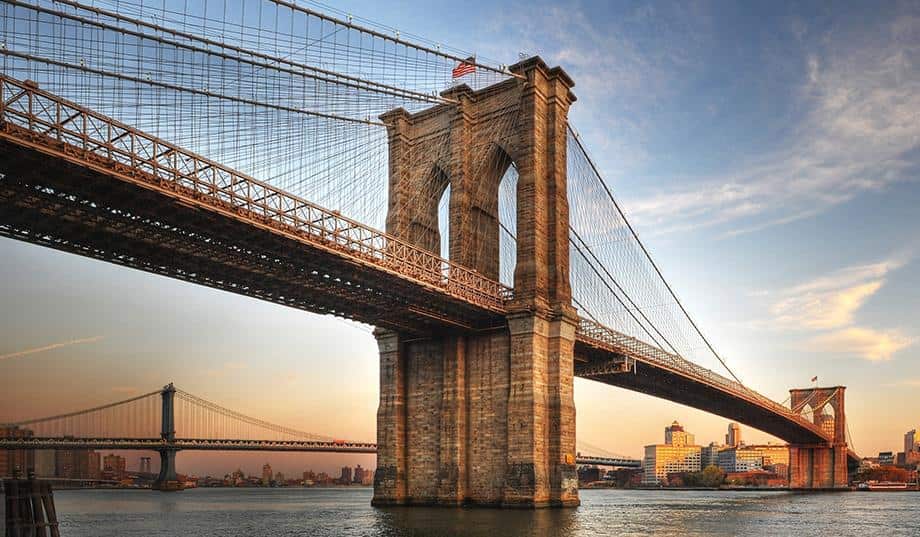
One of the first people to die during construction of The Brooklyn Bridge was John Augustus Roebling, the designer.
He envisioned a bridge that would be “the perfect equilibrium of nature”. Looks like his goal was accomplished, huh?
Sadly, he’d never see his dream come to fruition.
Three days after construction began a ferryboat crushed his right foot while he was trying to figure out where the bridges’ towers should be placed. Rumor has it he didn’t scream, but instead went on barking orders. His doctor said he’d need to amputate his toes, but Roebling refused because the after care instructions seemed too tedious. “No, no, no. Just soaking it in water will be ok”. He died a few weeks later from tetanus.
4. Roebling’s son took over and then got sick too.
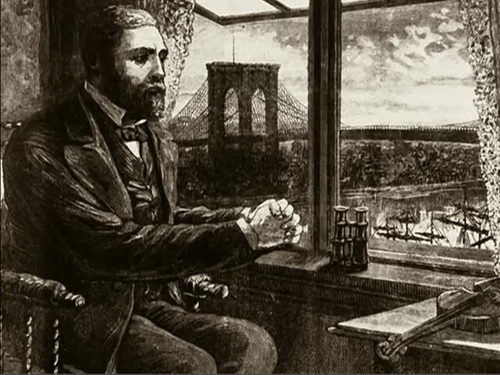
John Roebling’s son, Washington Roebling, took control over the Brooklyn Bridge’s construction after his father died. It was Washington’s idea to use caissons as the foundation of the bridge’s towers. He installed two caissons that were the largest pneumatic caissons ever built, larger than four tennis courts!
Washington spent so much time in the caissons that he got “caisson sickness” in 1872. So did at least 110 of his workers. He didn’t die, but the sickness was so intense he was bedridden.
Washington and his wife Emily moved from Trenton, NJ to Brooklyn Heights so Washington could watch bridge construction from his window.
5. What the Brooklyn Bridge has to do with feminism.

Washington’s’ wife, Emily Roebling, took over as chief field engineer of the Brooklyn Bridge after her husband became bedridden. She had to convince Henry C Murphy, the President of New York Bridge Company, that Washington was capable to continue his duties as Chief Engineer. Luckily, he agreed.
When asked about his illness Washington said, “I thought I would succumb, but I had a strong tower to lean upon, my wife, a women of infinite tact and wisest counsel”.
Emily was not an engineer, but she understood the plans so thoroughly that she could talk with other engineers. Many people were under the impression that she was the real designer.
At the dedication ceremony before the opening of the bridge, Congressman Abram S. Hewitt said the Brooklyn Bridge was, “An everlasting monument to the self-sacrificing devotion of woman.” He continued, “The name of Mrs. Emily Warren Roebling will thus be inseparably associated with all that is admirable in human nature”.
6. The first to cross the Brooklyn Bridge was a rooster.
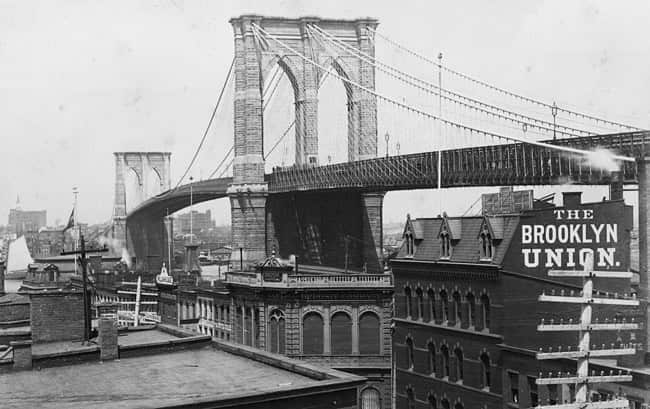
Well, not technically, Emily Roebling was the first to cross the bridge. Her husband, Washington Roebling, asked Emily to be the first one across. Emily rode in a carriage from the Brooklyn side to the Manhattan side while carrying a rooster on her lap. The rooster is a symbol of victory. Within 24 hours over 100,000 people crossed the bridge!
Pretty crazy stuff, huh? Almost seems like the Brooklyn Bridge was doomed to fail! Only 15 years later Brooklyn was convinced to become one of the 5 boroughs of NYC hence losing its status as a city. That happened in 1898. Here in Brooklyn we call that the “mistake of ’98”. So maybe the bridge god’s were trying to tell us something







